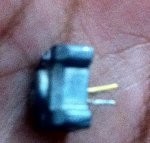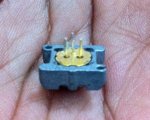No. Just plain "NO". Do not rely on some mechanical limitation on that pot to set the minimum resistance it will deliver. If the mechanical limit fails, bends, breaks off, etc, your laser diode is going to go POOF. Furthermore, we're talking about the difference of FRACTIONS of 1 ohm being enough to cook your diode. 2.9 ohms might be OK, 2.8 ohms is going to give you 10% more power. That's a really narrow range.
Do the right thing, and figure what the MAXIMUM current you want to deliver is, and put the appropriate resistor in series with the pot to guarantee it won't exceed that value. Then, if you zero the pot, you have nothing to worry about.
Go to Mouser Electronics' web site and look at the available resistor values. There's no such thing as a 5 ohm resistor - which is why the original design used two 10-ohm resistors in parallel, which GIVES you 5 ohms (1 / 2x10 = 5 -- part of Ohm's law).
You can buy a 2.7 ohm resistor or a 3.0 ohm resistor. I'd go for the 3.0 resistor and drive the diode a little UNDER your 420 mA goal.
Greg








